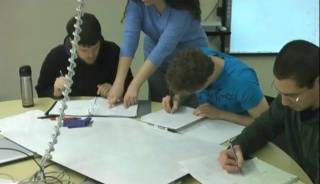You are here: start » activities » main
Superposition States for a Particle on a Ring
Highlights of the activity
- This small group activity is designed to help students find probability amplitudes of superposition states for a particle confined to a ring.
- Students work in small groups to calculate the probability for angular momentum, energy, and position of a specific superposition state for particle on a ring.
- The entire class wrap-up discussion stresses that breaking up a given wavefunction into a superposition of eigenstates is most beneficial in these types calculations.
Reasons to spend class time on the activity
Students readily grasp the strategy of finding probability amplitudes “by inspection” when they are given an initial state written as a sum of eigenstates. However, students then find it extremely difficult to find probability amplitudes of wavefunctions that are not written this way (i.e. using an integral to find the expansion coefficients of a function). This activity provides an opportunity to deal with a state that is not easily separated into eigenstates.
Reflections
Instructor's Guide
Student Handouts
Authors: Corinne Manogue, Kerry Browne, Elizabeth Gire, Mary Bridget Kustusch, David McIntyre
To edit this page, go here
